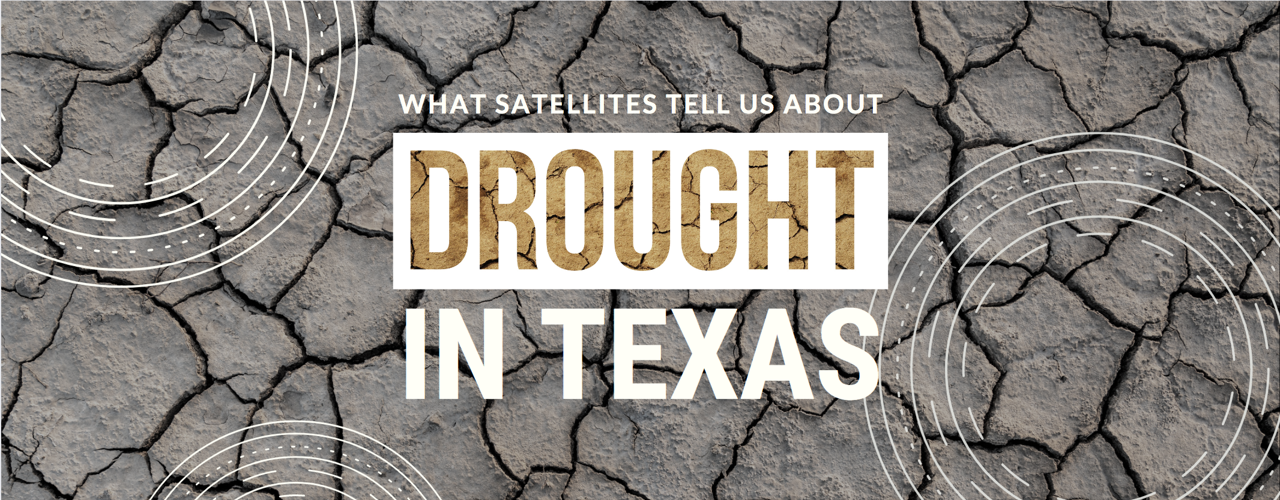

Featured Map: What satellites tell us about drought in Texas
Scientists employ various methods, models and data to track weather patterns, including drought – a condition closely monitored by Texans, especially those involved in agriculture and natural resources. As a common resource, you're probably familiar with the U.S. Drought Monitor (USDM), often referenced by meteorologists to show the severity and location of drought. A broad network of experts develop the USDM using the “best available data” and local knowledge (What is the USDM | U.S. Drought Monitor (unl.edu)).
During a weather report, meteorologists often show us cloud cover from satellite images, especially during hurricane season and periods of heavy rainfall. Did you know satellites are also used to detect and monitor drought? One example is NASA’s Moderate Resolution Imaging Spectroradiometer (MODIS) satellite. Images collected with this satellite help scientists create the Vegetation Drought Response Index (VegDRI), an indicator of vegetation stress due to drought. Made available to the public through the USGS Earth Resources Observation and Science (EROS) Center on a weekly basis, VegDRI “[integrates] remote sensing, climate, and biophysical data to provide timely drought information for the conterminous United States”. The satellite can “see” parts of the light spectrum beyond what is visible to humans, meaning it can help us measure how vigorously plants are growing or how stressed plants are based on the amount of light absorbed or reflected at certain light wavelengths involved in plants converting sunlight to energy. Who would have thought photosynthesis and satellites working together could produce incredibly insightful data? Science!
Let's take a look. The following maps are taken from the VegDRI across a series of dates showing the change in drought over a year and then over the last two months. Note that the darkest red represents extreme drought, the darkest green represents extreme moisture and the white represents near-normal conditions.
General trends and observations
Drought was almost non-existent in August 2021 in the state. Almost all of Texas was impacted by some level of drought in August 2022. Rainfall in August provided relief, but without sustained rainfall, drought is already increasing again.
Other interesting facts from the U.S. Drought Monitor
- August 3, 2021 – Approximately 14,000 sq. mi. (5%) of Texas was in any drought category (D0-D4), affecting approximately 135,000 people (<1% of the state’s population).
- August 2, 2022 – Approximately 263,000 sq. mi. (99%) of Texas was in any drought category (D0-D4), affecting approximately 28,752,000 people (96% of the state’s population). 72% of the population experienced “extreme” and “exceptional” drought (categories D3-D4) at this time.
- September 6, 2022 – Approximately 20,066,500 people (67% of the state’s population) were affected by drought (D0-D4). 11% of the population experienced “extreme” and “exceptional” drought (categories D3-D4) at this time.
- September 27, 2022 – Approximately 21,264,500 people (71% of the state’s population) were affected by drought (D0-D4). 11% of the population experienced “extreme” and “exceptional” drought (categories D3-D4) at this time.
Learn More
Texas Land Trends
Informing private and public decision-makers about the status and trends of our state’s working lands


 VegDRI on August 1, 2021 showing minimal drought.
VegDRI on August 1, 2021 showing minimal drought.
 VegDRI on July 31, 2022 showing widespread drought a year later.
VegDRI on July 31, 2022 showing widespread drought a year later.
 VegDRI showing us the response from rainfall on September 4, 2022 and a followup regression after no additional significant rain on September 25, 2022.
VegDRI showing us the response from rainfall on September 4, 2022 and a followup regression after no additional significant rain on September 25, 2022.









